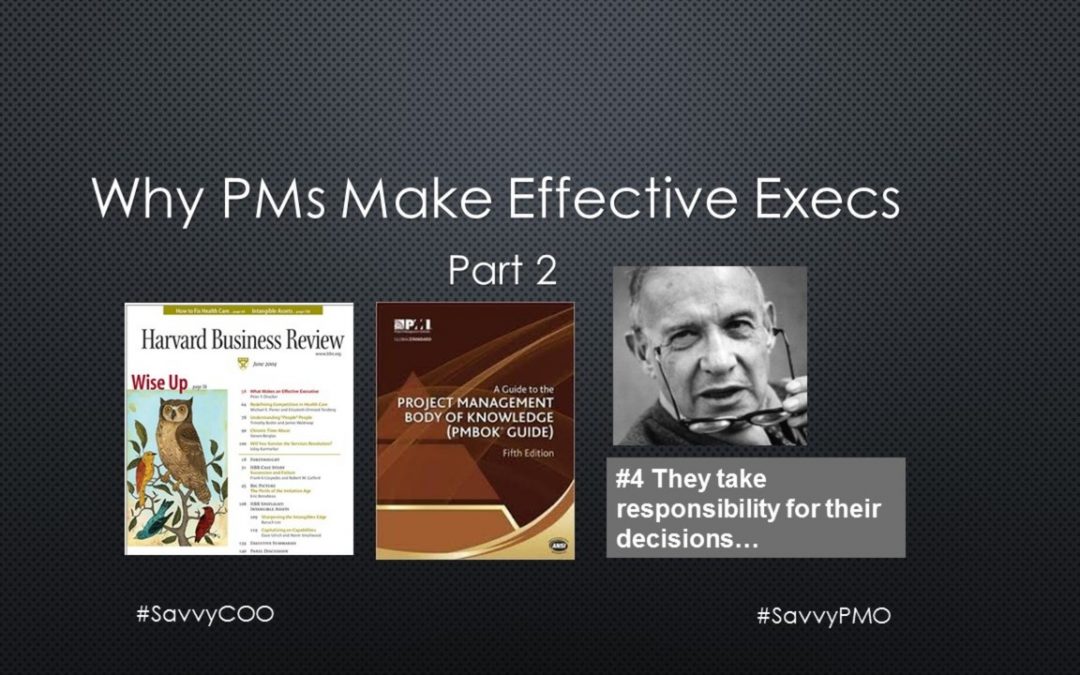So why do good project managers make great executives?
What Makes an Effective Executive?
First let’s answer the question: What makes a great executive? In 2004 Peter Druckerpublished an article in the Harvard Business Review titled “What Makes an Effective Executive”
He applied his first-hand knowledge working with some of the world’s best business leaders over a 65-year consulting career. He found that the most effective executives followed the same eight practices:
1. They asked, “What needs to be done?”
2. They asked, “What is right for the enterprise?”
3. They developed action plans.
4. They took responsibility for decisions.
5. They took responsibility for communicating.
6. They were focused on opportunities rather than problems.
7. They ran productive meetings.
8. They thought and said “we” rather than “I.”
Good Project Management Practices=Effective Executive Practices
Good project management lines up with those executive best practices. By applying the the 47 PMBOK processes, the 5 process groups, and the 10 knowledge areas, project managers model those best practices.
In part 1, we looked at best practices 1 through 3. Here (Part 2) we will examine executive best practices #4: They took responsibility for their decisions.
Good project managers, like good executives take responsibility for their actions. This is more than simply saying “I’m responsible.” It’s taking a disciplined approach to decision making, decision communication, and decision review.
According to Drucker a decision has not been made until people know:
- the name of the person accountable for carrying it out
- the deadline
- the names of the people who will be affected by the decision and therefore have to know about, understand, and approve it—or at least not be strongly opposed to it
- the names of the people who have to be informed of the decision, even if they are not directly affected by it.
In essence, Drucker outlined a decision checklist. This “checklist” should be very familiar to any project manager who has used a RACI chart, especially when combined with the project schedule (to define the “deadline”).
The above example is Figure 9-5 from PMBOK 5.0. A RACI chart is one the HR Management Tools and techniques found in PMBOK 9.1 Plan Human Resources Management.
A project manager will couple the HR Planning with Stakeholder management which further refines “the people who will be affected by the decision.”
In addition, the PMBOK describes the role of the Project Manager in section 1.7: “The project manager is the person assigned by the performing organization to lead the team that is responsible for achieving the project objectives.” And in section 1.7.1: “In general, project managers have the responsibility to satisfy the needs: task needs, team needs, and individual needs.” Responsibility is integral to the project manager’s role.
Drucker further goes on to describe the importance of systematically reviewing decisions on a periodic basis-checking the outcome of decisions against the expectations. According to Drucker this “shows executives what their strengths are, where they need to improve, and where they lack knowledge or information. It shows them their biases.” This is very much like the activities of the project manager in PMBOK 4.6 Close Project or Phase. This is especially true where the project manager documents lessons learned as part of Organizational Process Updates.
Practice Makes Perfect
You can easily see how good project management practices and practicing the skill sets associated with the PMBOK processes prepare project managers to apply Drucker’s executive best practices. We’ll examine the next best practice (Item 5) in a future post.
Questions for you
- Do you agree with the premise good project managers make good executives?
- Are the executive best practices listed by Drucker still valid today?
- Do PMBOK processes truly prepare you to implement these executive best practices?
If you enjoyed this post or found it useful, please follow me above and @opscoo on twitter.
You might also be interested in the following related posts:
- Why Project Managers Make Effective Executives (Part 1)
- JFK’s Gift to Project Management
- Earthday: Saving the Planet with Project Management
- Project Managers Save Europe
- Top 5 Leadership Lessons From the Army
About the author:
Mike has the most interesting job in the world: He’ll help you quickly improve profits/ROI and achieve awesome project results either working inside your organization (fractional/interim COO or PMO) or leading a Confoe solution/project team. He’s worked around the world and across companies, industries, and technologies. Mike has appeared in numerous publications including Fast Company, US News & World Report, Renewable Energy World, Platt’s Energy Economist, and Sun and Wind Energy.
About Confoe:
Since 2002, Confoe has provided project management services, consulting, and custom software solutions for clients ranging from the Fortune 50 to new venture start-ups. Clients have included: Whole Foods Market, Intel, Dell, SoloPower, HelioVolt, and the Environmental Defense Fund








Recent Comments